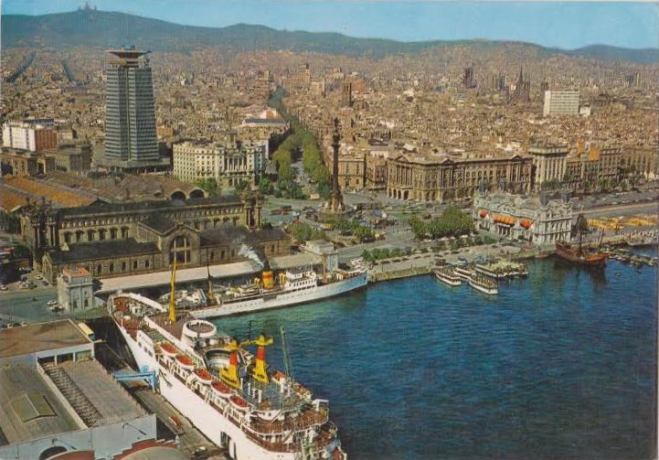
It was 1973, when the misogynistic sex comedy Manolo la nuit was screened in Spain, having been directed by a pro-dictatorship filmmaker. Foreign women appeared to be enjoying the sun at a Spanish coast. What they did not appreciate was the flirt from young men who were not natives. Suddenly, however, a local macho guy entered triumphantly the scene; his presence was a tonic that enthused those foreign tourists.[1] Around 35 years after the Francoist troops had stormed the area, tourists were rendering it their playground. The more moderate members of the Nationalist regime in Spain actively sought to attract them, in order to challenge the image of the country as an inwards-looking, ascetic one and to help integrate it into consumer capitalism. A “peaceful invasion”[2] had actually been evident coastal Spain since the 1960s, when hundreds of thousands of tourists from Northern Europe, soon to become millions, craved for a vacation there. Commercial travel agencies, such as Neckermann from West Germany, offered cheap charter holidays in Spain.[3] The youth figured prominently in the desirable clientele of such agencies: the 1971 brochure of the TUI branch that addressed youngsters, Twen Tours, featured colorful images of teenagers having fun at resorts, such as Benidorm and Torremolinos. Quite a few of those visitors from Britain and Germany, young and more elderly, seem to have fallen in love with the place, becoming lifestyle migrants: they have purchased a house there and, especially from the moment they become pensioners, they split their time between Spain and their country of origin.
In this context, the Spanish shipping company Trasmediterranea ordered in the mid-1960s the construction of four ferry boats to Spanish shipyards. Actually, the ferry boats in general appeared in the mid-1960s. Europeans began to afford paid vacations and they can also travel with their own car. Ferry boats quickly became the dominant type passenger ship replacing, in the vast majority of routes, the ‘pure’ passenger ships. From Dover – Calais to Patras – Brindisi routes the ferry boats took over. The transition was fast, probably following the pace of the rise of the living standards and the consuming trends but it didn’t happen overnight. The two different types of passenger vessels co-existed for a couple of years as someone can notice in this magnificent postcard.
Spain did not remain unaffected by the advent of the ferry boat. The first two sister ships, JUAN MARCH and LAS PALMAS DE GRAN CANARIA , were built by Union Naval de Levante S.A. (Valencia), while the following two sister ships, SANTA CRUZ DE TENERIFE and CIUDAD DE COMPOSTELA were built by Sociedad Espanola de Construccion Naval (Bilbao). The four sister ships were facilitating the Balearic and Canaria routes and they remained under the ownership of Trasmediterranea until the mid 1980s. Being built during the period of transition , their garages proved to be small after a while; they could carry ‘only’ 100 cars and no freighters. The four sister ships had to be replaced.
Some of the ships owned by Trasmediterranea appear in the postcard, as manifest by their white livery and the yellow-red funnel. The identity of the smaller passenger vessel remains a mystery to us. We couldn’t find out, although we have tried hard! Can you?
Hint for ship enthusiasts: SANTA CRUZ DE TENERIFE was scrapped in 1987 after a fire in the engine room. Her career as SOL OlYMPIA II proved to be extremely short. CIUDAD DE COMPOSTELA caught fire and sank in 1994. She was operating between Greece and Italy under the name SARAY STAR. LAS PALMAS DE GRAN CANARIA was rebuilt as cruise ship. She sailed until 2005, when she capsized under the weight of water pumped in order to extinguish a fire on board. The accident took place in Taiwan. Her last name was ROYAL PACIFIC. JUAN MARCH was also rebuilt as cruise ship. In the age of 50, she still sails the sea. Her current name is OCEAN MAJESTY.
Salty Deck Question: Have you visited the Spanish coast as a youngster? Did you travel around by ship? Don’t hesitate to share your memories and any relevant material, such as photos, by responding to this post or by submitting a story.
[1] Justin Crumbaugh, Destination Dictatorship. The Spectacle of Spain’s Tourist Boom and the Reinvention of Difference, New York 2009.
[2] Sasha Pack, Tourism and dictatorship: Europe’s peaceful invasion of Franco’s Spain, New York 2006.
[3] Christopher M. Kopper, ‘The Breakthrough of the Package Tour in Germany after 1945’, Journal of Tourism History, vol. 1, issue, 1, pp. 67-92.
‘Ibiza la isla blanca’
https://www.youtube.com/watch?v=oBuTN2w7i28 (1947)
https://www.youtube.com/watch?v=B47lxfYtvoM (1960)
LikeLike
Many thanks, Panayioti!!
LikeLike